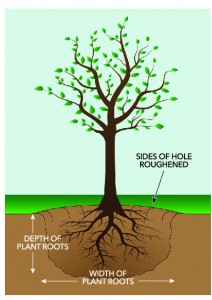 Don’t plant too deep. The top of the root ball or plant crown should be at the same level or just one-half inch above the surrounding soil. If planted too deep, the plant stem can rot and the roots suffocate.
Don’t plant too deep. The top of the root ball or plant crown should be at the same level or just one-half inch above the surrounding soil. If planted too deep, the plant stem can rot and the roots suffocate.- Disturb roots. Remove the plant from the pot and pull loose roots outward and cut or straighten any that are encircling the root ball. This encourages the roots to grow into the surrounding soil. If it no longer looks like a root ball, you’ve done well.
- Don’t dig your hole too deep. Dig a saucer-shaped hole that is 2–3 times the width of the root mass. Build a mound of soil at the bottom of the hole. Splay out the roots so they are pointing to the surrounding soils.
- Don’t add soil amendments. Coastal plants are adapted to low-nutrient soils. Adding fertilizer or compost in your planting hole will encourage weeds as well as discourage the roots from spreading into native soils.
- Don’t stomp! We were taught to really pack those roots down—sometimes even pushing down with our feet. This can tear the roots off your plant, which definitely isn’t good for them. Compact the soil with your hands.
- Water plants immediately. Watering will settle the soil and eliminate air pockets. Add more soil to holes
that appear. If you are adding mulch as a weed suppressant, be sure to keep the mulch from touching the stem of the plant. Newly planted natives need regular watering their first two to three years until they’re established in a landscape. Water more the first summer, and much less with each passing year so the plants adapt to the drought conditions they’ll ultimately have to endure on their own.
For more home gardening information go to gardening.wsu.edu.